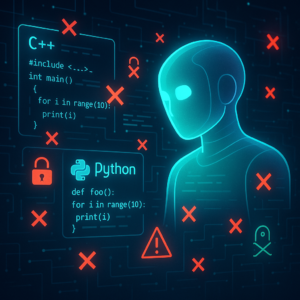Unpacking the Hidden Bugs in AI Libraries: A Glimpse into the Future of Deep Learning

Unpacking the Hidden Bugs in AI Libraries: A Glimpse into the Future of Deep Learning
Welcome to the curious world of deep learning libraries! Imagine a beautifully designed car that occasionally forgets to check if its engine is functioning before starting up. That’s pretty much what happens when “checker bugs” sneak into deep learning libraries like TensorFlow and PyTorch. These bugs often reside in the underbelly of DL libraries, hiding in the error-checking and input validation sections of the code. Now, let’s dive into this fascinating research conducted by a group of insightful minds aiming to tackle these pesky issues to ensure our AI systems remain robust and reliable.
Understanding Checker Bugs: The Blind Spots of Deep Learning
What’s the Deal with Checker Bugs?
In plain terms, checker bugs are those system hiccups that occur when certain validation checks in software systems are either absent or flawed. Imagine trying to build a LEGO tower blindfolded — without seeing the misaligned pieces, things are bound to crash. This analogy illustrates how these bugs can lead to incorrect system outputs, crashes, and unexpected behaviours, all without sounding any alarms until significant problems arise.
The Special Case of Deep Learning Libraries
Unlike traditional software that relies on standard data structures, DL libraries revolve around tensors. Tensors are those multi-dimensional arrays crucial for machine learning tasks. The lack of proper validation of these tensor properties is what brings unique challenges to deep learning systems.
Take, for instance, a hypothetical PyTorch bug where a developer forgets to check if a certain index is within the dimensions of a tensor. Such oversight can spell disaster for tensor operations and data processing. Therefore, understanding and fixing such bugs is crucial to improve the performance and reliability of AI systems.
The Pathfinder: Introducing TensorGuard
What’s New with TensorGuard?
Enter TensorGuard — a cutting-edge tool developed through this research to automatically snuff out and patch these checker bugs in DL libraries. It’s like having a diligent night guard who doesn’t just watch over but also fixes the creaking doors of a bustling AI factory. TensorGuard is built upon advanced technology that uses a combination of Large Language Models (LLMs) like OpenAI’s GPT-3.5 and a clever database setup known as Retrieval-Augmented Generation (RAG).
The Magic Behind TensorGuard
TensorGuard utilizes a unique strategy to assess and patch bugs through a step-by-step process algorithmically guided by various “agents.” These agents employ sophisticated prompting strategies, including the philosophical sounding “Chain of Thought,” to identify and evaluate the severity and roots of bugs, generate appropriate code patches, and implement these fixes effectively.
From Identifying Problems to Implementing Solutions
Classifying the Pesky Intruders
One big breakthrough was developing a taxonomy for these bugs to better understand them. This study discovered that compared to traditional software, DL libraries have a wide array of checker bugs and symptoms, which are mostly linked to tensor properties, device issues, and computation graph management.
Tackling Root Causes and Symptoms
Symptoms from these bugs can range from program crashes to performance slowdowns and more elusive problems like runtime errors and unexpected behaviors. By identifying the common patterns, TensorGuard can strategically address problem areas across various layers of deep learning systems.
Real-World Success in AI Libraries
TensorGuard’s test run was quite impressive. It successfully sniffed out 64 previously unknown bugs in JAX, a DL library by Google, and even managed to fix four of them. So, while it doesn’t yet boast a perfect track record, TensorGuard’s emerging prowess could mean fewer hiccups and smoother rides for AI development projects.
Breaking Down Complex Concepts: A Simple Look at TensorGuard’s Structure
The Brainy Components: RAG and LLMs
Think of TensorGuard as a hybrid brainiac with an extensive memory bank and sharp problem-solving skills. The RAG database stores and retrieves vast memory files or code changes, while the LLMs like GPT-3.5 make sense of the data and patch the checker bugs.
Understanding Prompting Strategies
With terms like “Chain of Thought” (COT), “Zero-Shot,” and “Few-Shot,” TensorGuard’s approaches might sound like moves from a chess game! These strategies guide TensorGuard in uncovering checker bugs without needing mountains of explicit examples — a feat that stands testament to modern AI’s intuitive capabilities.
Path Forward: A Consideration of Real-World Impact
Benefits for AI Developers and Tech Giants
This study sets new standards by offering practical strategies that AI librarians can use to sidestep and mitigate checker bugs. It provides a sturdy framework for industry players like Google and Meta to improve system reliability and efficiency, minimizing unexpected failures and operational costs.
Opening Doors for Future Research
There’s an open invitation for developers and researchers to explore TensorGuard’s dataset and source code, potentially paving the way for more refined bug-detection tools. The future looks promising, with the potential to revolutionize the upkeep of DL libraries, inspiring countless innovations in AI research and applications.
Key Takeaways
Now, let’s round things off with some key takeaways:
- The Unseen Trouble: Checker bugs in DL libraries often lurk unnoticed but can wreak havoc on AI software reliability and performance.
- TensorMagic: TensorGuard represents the future of AI maintenance, assessing and repairing checker bugs using state-of-the-art LLMs and RAG databases.
- Practical Impact: TensorGuard has been pivotal, identifying new bugs in notable libraries like JAX, setting the stage for leaner, safer AI operations.
- The Road Forward: With further advancements, TensorGuard opens new possibilities for AI developers and researchers to enhance reliability in machine learning systems.
Whether you’re a deep tech enthusiast or someone dabbling in AI, understanding and addressing these hidden bugs in our foundational libraries is an essential piece of the puzzle in ensuring the seamless future of machine learning technology. Dig deep, explore, and perhaps contribute to the next wave of AI innovation!
If you are looking to improve your prompting skills and haven’t already, check out our free Advanced Prompt Engineering course.
This blog post is based on the research article “Checker Bug Detection and Repair in Deep Learning Libraries” by Authors: Nima Shiri Harzevili, Mohammad Mahdi Mohajer, Jiho Shin, Moshi Wei, Gias Uddin, Jinqiu Yang, Junjie Wang, Song Wang, Zhen Ming, Jiang, Nachiappan Nagappan. You can find the original article here.




